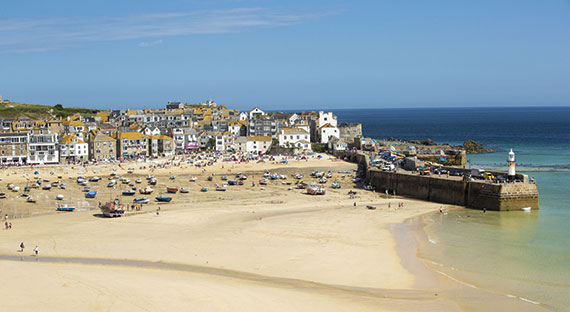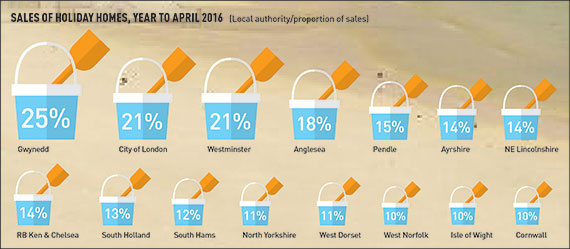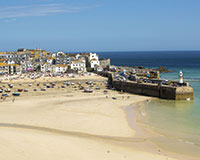 It’s yin and yang. On the one hand, St Ives is a classic Cornish holiday destination, all cream teas and wheeling seagulls. On the other hand, it has become the focus of a housing issue dividing many in 21st century Britain: the second home.
It’s yin and yang. On the one hand, St Ives is a classic Cornish holiday destination, all cream teas and wheeling seagulls. On the other hand, it has become the focus of a housing issue dividing many in 21st century Britain: the second home.
In the town’s recent referendum some 3,075 residents (42.7% of the voting population) voted for the St Ives Area Neighbourhood Development Plan, with 616 against. The vote has endorsed clause H2, a provision that any new-build home must in future be for owner-occupiers and not holiday home purchasers or buy-to-let investors.
With a welter of publicity around the vote (the town’s mayor has been interviewed by Canadian, New Zealand and Israeli media) and with Cornwall county seen as a holiday home haven (10% of its 242,213 housing units are second properties, says Countrywide) St Ives has become a symbol of the debate.
The arguments for and against second homes – that is, holiday homes in tourist areas or pieds-à-terre in central London, rather than long-term rented buy-to-lets – are familiar enough. Supporters say holiday home buyers pump money into local economies and raise the standard of housing stock; opponents say they inflate house prices and thus reduce supply and affordability for locals.
Second home buyers are location driven. It’s more about situation and less about property – and ideas on location are very fixed
But just how big an issue is this? And would more drastic action to curtail future growth of second homes actually help the nation’s housing crisis?
Some 1.6m people in the UK own additional properties but only 165,095 told the 2011 Census their second home was chiefly for holidays. Sector churn is low: Countrywide calculates average holiday home ownership at 20 years, three times that of owner-occupied property. “Early signs are the new stamp duty rates haven’t had much of an effect on second homes,” says Johnny Morris, Countrywide’s head of research.
There is also some circumstantial evidence of higher prices in second home locations.
For example, Savills’ analysis shows that homes sold within 100 metres of the Cornish coast attract a 10.4% premium compared with those sold in the belt of 100m to 1km inland – although such premiums are paid by owner-occupiers wanting a sea view as well as second-homers.
Likewise Countrywide’s sale data (see box) shows second home buyers typically paying above-average prices in local authority areas – some 10% or more of stock is in this category. What is more arguable is whether this is because second-homers simply choose to buy higher-priced stock or whether their very presence drives up prices more generally.
One planning option is to designate a scheme for holiday homes in the hope that buyers follow. The Lakes scheme, by Raven Group and niche developer YOO, is in a landscaped 650-acre Gloucestershire quarry; it won consent in 2008 as the credit crunch began to bite, with Cotswold Council hoping this would draw second-home buyers from the existing stock.
But there has been little sign that the scheme has stopped significant second home sales nearby. This is no surprise to Savills’ second homes expert Jonathan Cunliffe. “There’s no evidence this works. Generally, second home buyers are location driven. It’s more about situation and less about property – and ideas on location are very fixed,” he says.
 Unsurprisingly, the St Ives vote is being seen by other councils as a template for action. South Lakeland, Aldeburgh and South Hams councils in the Lake District, Suffolk coast and south Devon respectively are among those admitting interest in doing the same.
Unsurprisingly, the St Ives vote is being seen by other councils as a template for action. South Lakeland, Aldeburgh and South Hams councils in the Lake District, Suffolk coast and south Devon respectively are among those admitting interest in doing the same.
They are waiting to see if a judicial review of the referendum, sought by Penzance-based developer RLT Built Environment, gets the green light. “This decision has an effect on our business but also for the whole of the St Ives economy, which is 90% reliant on tourism and services. The only way to get affordable housing development is to allow development at open market value,” says RLT director Steve McTeare, who is building in St Ives.
“This policy will cap the open market value of new homes and will push up the prices for existing housing. It will have the opposite of the desired effect,” he says.
If the judicial review goes ahead, it will be held in the autumn. If the process backs St Ives’ original result, expect more council votes in the near future; if the review wins, St Ives has hinted it will amend its procedures and do a re-run next year.
Either way, attitudes to second homes in an era of housing shortages appear to be hardening among policy makers. This issue isn’t going away any time soon.











